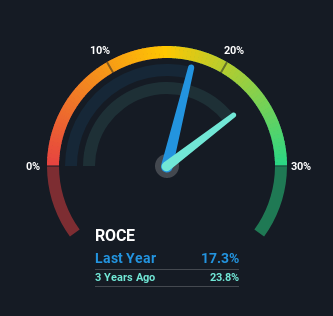- United States
- /
- Food
- /
- NasdaqGS:MZTI
Lancaster Colony (NASDAQ:LANC) Could Be Struggling To Allocate Capital

Did you know there are some financial metrics that can provide clues of a potential multi-bagger? Ideally, a business will show two trends; firstly a growing return on capital employed (ROCE) and secondly, an increasing amount of capital employed. This shows us that it's a compounding machine, able to continually reinvest its earnings back into the business and generate higher returns. However, after briefly looking over the numbers, we don't think Lancaster Colony (NASDAQ:LANC) has the makings of a multi-bagger going forward, but let's have a look at why that may be.
Return On Capital Employed (ROCE): What is it?
For those that aren't sure what ROCE is, it measures the amount of pre-tax profits a company can generate from the capital employed in its business. To calculate this metric for Lancaster Colony, this is the formula:
Return on Capital Employed = Earnings Before Interest and Tax (EBIT) ÷ (Total Assets - Current Liabilities)
0.17 = US$164m ÷ (US$1.1b - US$173m) (Based on the trailing twelve months to December 2021).
Therefore, Lancaster Colony has an ROCE of 17%. On its own, that's a standard return, however it's much better than the 9.3% generated by the Food industry.
View our latest analysis for Lancaster Colony

Above you can see how the current ROCE for Lancaster Colony compares to its prior returns on capital, but there's only so much you can tell from the past. If you'd like, you can check out the forecasts from the analysts covering Lancaster Colony here for free.
What Does the ROCE Trend For Lancaster Colony Tell Us?
When we looked at the ROCE trend at Lancaster Colony, we didn't gain much confidence. Over the last five years, returns on capital have decreased to 17% from 32% five years ago. Although, given both revenue and the amount of assets employed in the business have increased, it could suggest the company is investing in growth, and the extra capital has led to a short-term reduction in ROCE. And if the increased capital generates additional returns, the business, and thus shareholders, will benefit in the long run.
What We Can Learn From Lancaster Colony's ROCE
In summary, despite lower returns in the short term, we're encouraged to see that Lancaster Colony is reinvesting for growth and has higher sales as a result. In light of this, the stock has only gained 30% over the last five years. Therefore we'd recommend looking further into this stock to confirm if it has the makings of a good investment.
If you're still interested in Lancaster Colony it's worth checking out our FREE intrinsic value approximation to see if it's trading at an attractive price in other respects.
While Lancaster Colony may not currently earn the highest returns, we've compiled a list of companies that currently earn more than 25% return on equity. Check out this free list here.
New: Manage All Your Stock Portfolios in One Place
We've created the ultimate portfolio companion for stock investors, and it's free.
• Connect an unlimited number of Portfolios and see your total in one currency
• Be alerted to new Warning Signs or Risks via email or mobile
• Track the Fair Value of your stocks
Have feedback on this article? Concerned about the content? Get in touch with us directly. Alternatively, email editorial-team (at) simplywallst.com.
This article by Simply Wall St is general in nature. We provide commentary based on historical data and analyst forecasts only using an unbiased methodology and our articles are not intended to be financial advice. It does not constitute a recommendation to buy or sell any stock, and does not take account of your objectives, or your financial situation. We aim to bring you long-term focused analysis driven by fundamental data. Note that our analysis may not factor in the latest price-sensitive company announcements or qualitative material. Simply Wall St has no position in any stocks mentioned.
About NasdaqGS:MZTI
Marzetti
Engages in the manufacturing and marketing of specialty food products for the retail and foodservice channels in the United States.
Flawless balance sheet with solid track record and pays a dividend.
Similar Companies
Market Insights
Community Narratives



